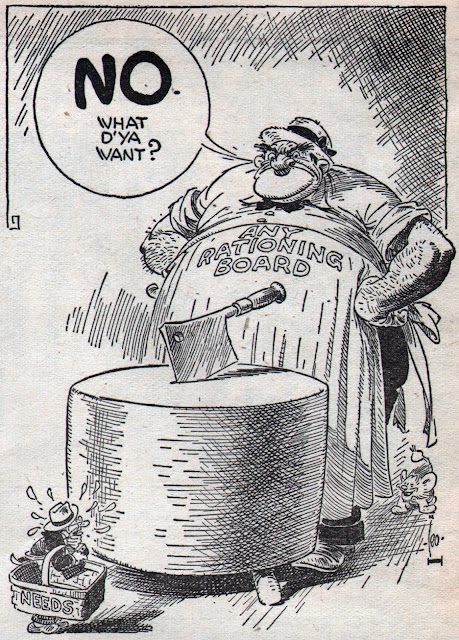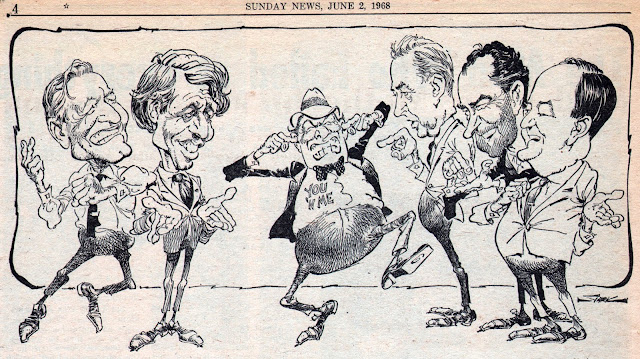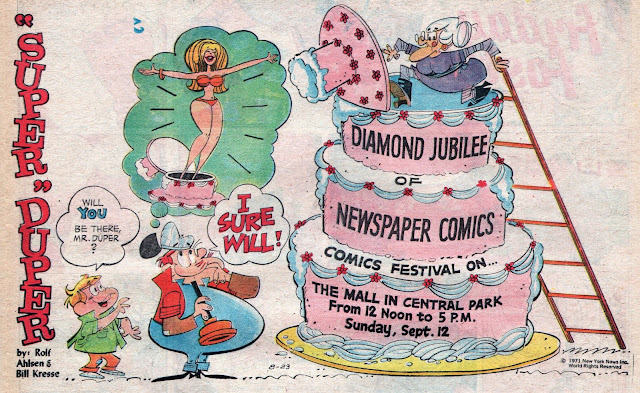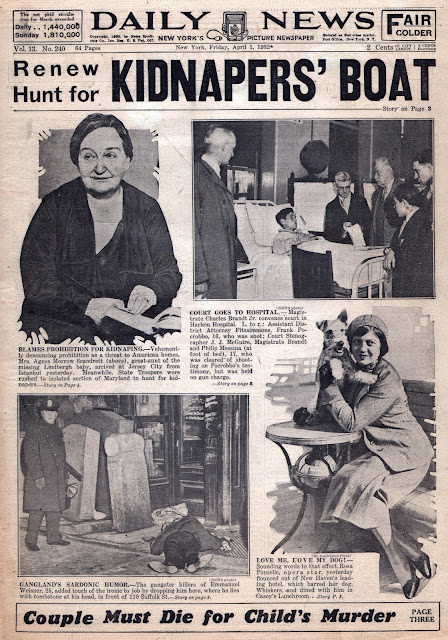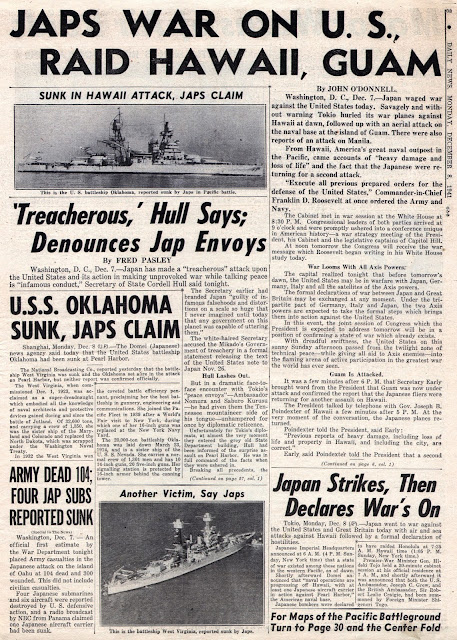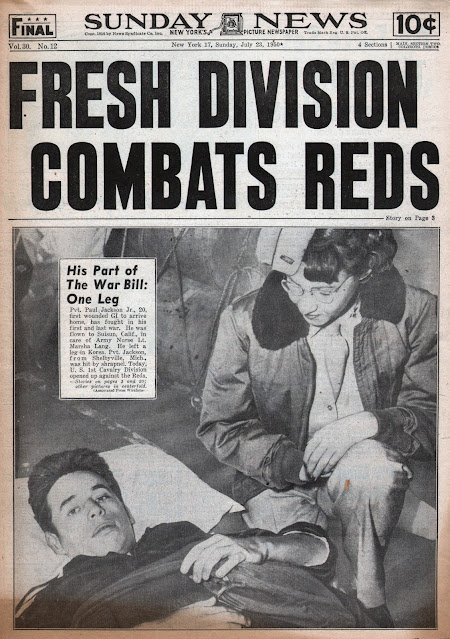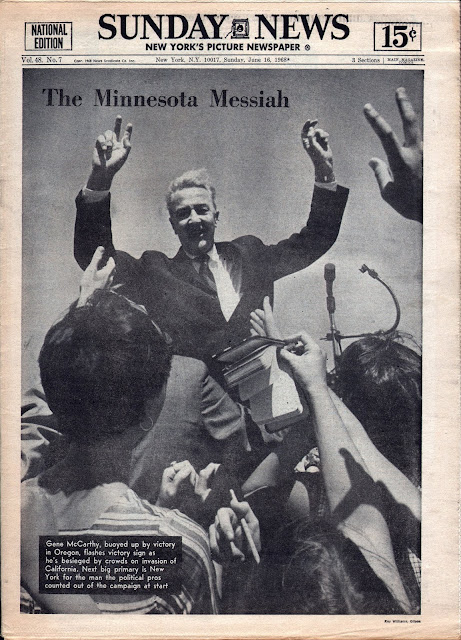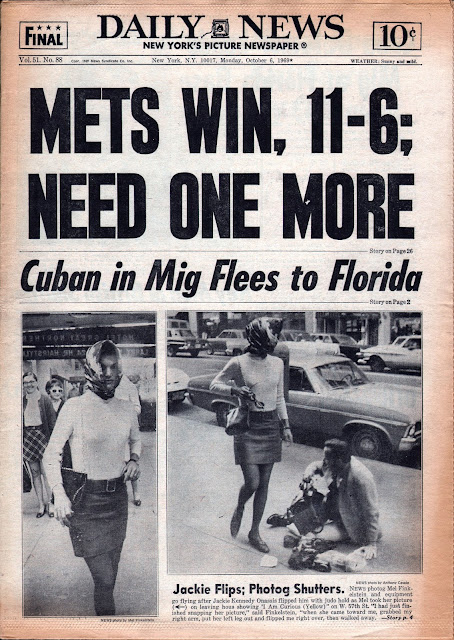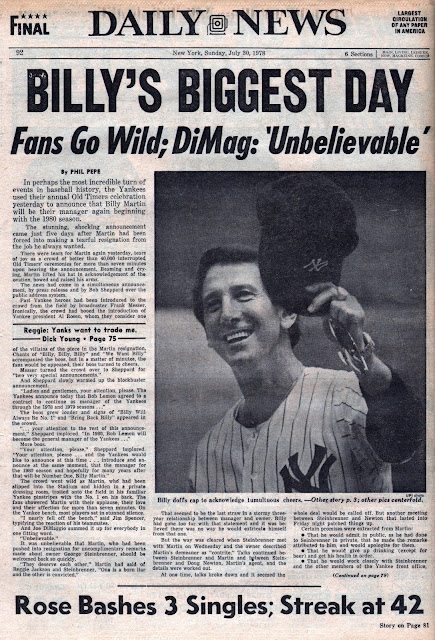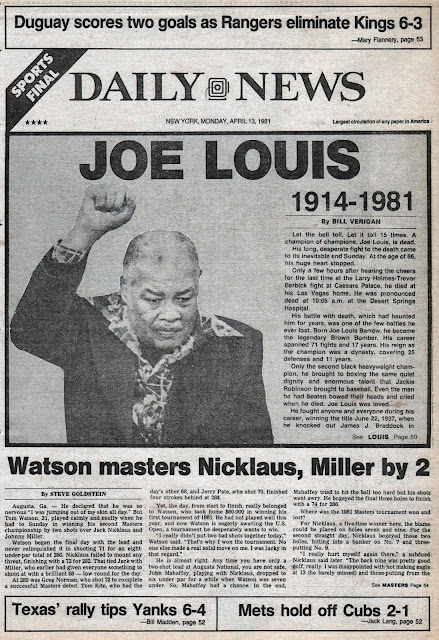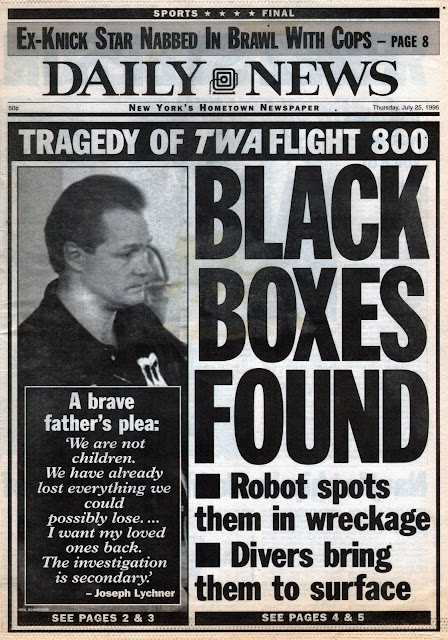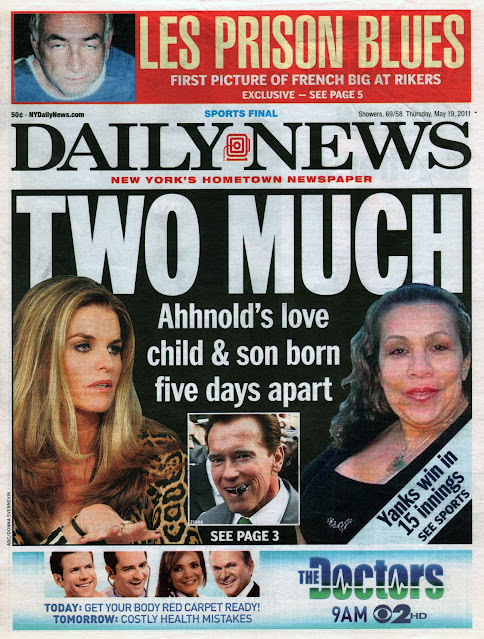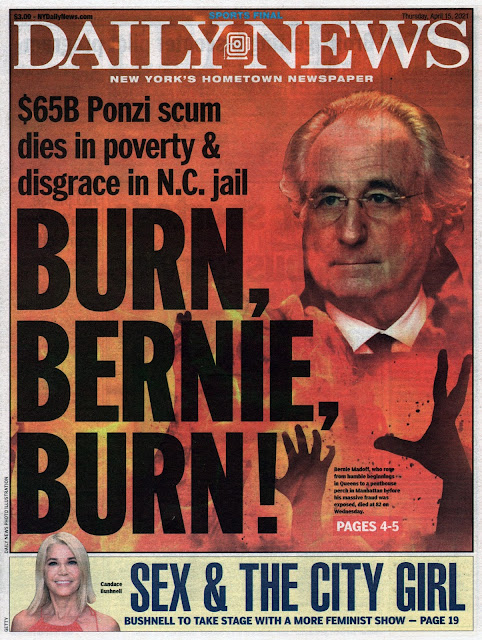A happy centennial anniversary to America's very first tabloid newspaper, THE NEW YORK DAILY NEWS, first appearing on the newsstands as The Illustrated Daily News 100 years ago today, June 26, 1919!
Legend has it that Captain Joseph Medill Patterson and his cousin Colonel Robert R. McCormick
conceived their new tabloid on the French battlefields of the first World War, heavily influenced by the British tabloid, The Daily Mirror. Their family owned and published The Chicago Tribune.
Patterson wanted a paper with verve and planned a "picture" newspaper that would have heady front-page photos to grab a reader's attention at the newsstands. The earliest years were tough and the paper almost went under, but shortly sales skyrocketed and by 1924 it was outselling every newspaper in the city...
Time limitations curtail my ability to delve deeply into the paper's history. In fact, just this past Sunday, June 23, 2019, the paper published a 120 page Sunday supplement celebrating its history (and have placed the supplement in each daily edition subsequent). Although 65 pages of ads, that still leaves 55 pages of NEWS history to explore in all its tabloid glory.
I'm not going to re-hash what's in the centennial supplement. It does a decent enough job covering so much ground. All the highlights are there, all the decades, all the big stories, all the photos. The great journalists are slanted more towards the latter half of the century, but that's to be expected. You will find mention of the great Jimmy Breslin, Pete Hamill, and Mike McAlary.
You will relive all the NY sports glory, including the great cartoonist Bill Gallo and the controversial Dick Young.(who gets a near full page treatment by Bill Madden) but nothing of sports columnist greats of the past like Hy Turkin, Jack Smith, Gene Ward or Joe Trimble. Even Pete Vescey's father Pete Vecsey Sr. had a sports by-line for a short period during the second world war.
There is also a small bit of coverage on their history of editorial cartoonists, highlighting the great Pulitzer Prize winning cartoonist C.D. Batchelor and the great Leo O'Mealia, as well as more current artists like Ed Murawinski and Bill Bramhall, without mention of Warren King, Joe Papin, Paul Rigby or Shoe creator Jeff MacNelly.. There's no way for me to compete with the newspaper itself in giving cheer to its own history, and the folks mentioned above are well known and their accolades well deserved.
May 10, 1933
February 25, 1934
February 17, 1935
December 21, 1943
August 27, 1944
October 1, 1944
October 8, 1944
November 19,1944
August 1, 1945
August 15, 1945
December 28, 1947
August 16, 1948
September 18, 1954
November 15, 1959
September 15, 1946
December 15, 1946
June 25, 1948
August 17, 1948
And guess what? That classic image above was originally the sports cartoon inside!An alternate photo cover also ran (see way down below) and the image appeared on page 84.
June 1, 1958
October 29, 1958
November 15, 1959
And thousands of small spot illustrations in the sports section, primarily in the 1940's and early 1950's.



GUS EDSON
But I've always been a champion of the lesser-knowns and the left outs. Do folks know that DONDI co-creator Gus Edson was a News sports cartoonist in the early 1930's? Edson drew the Sunday strip STREAKY before taking over the iconic THE GUMPS when Gumps creator Sidney Smith died in an automobile crash in 1935. When The Gumps had nearly run its course, Edson corralled artist Irwin Hasen and launched DONDI in 1955. But he started in the News sports department, both the main sports section cartoon and the article spot illustrations, as seen below. His position, upon leaving for the comics pages, was taken over by Leo O'Mealia.
April 1, 1932
The same can be said for long-time staff cartoonist, the late Bill Kresse. A wonderfully stylized artist, he was all over the newspaper in nearly every capacity for a near 15 year period of the late 1960's through the early 1980's, including his great Sunday strip, "Super" Duper, with Rolf Ahlsen.
I'm going to correct their omission right here on this blog. I'll only give cursory samples as I want to devote longer future articles here to the both of them.

*** The great Bill Gallo received well deserved accolades in the supplement. While I'm striving here to show people left out, no article on the New's history should be without a Bill Gallo mention. So here's my short celebration.....
In addition of some of the most beloved sports cartoons of all time, including his treasured Basement Bertha, Gallo did spot illustrations all over the paper, although primarily in the sports section, accompanying columnists like Dick Young.
And let it be known that Bill Gallo turned his Basement Bertha sports character into a rarely run Sunday comics feature Bertha between 1972 and 1979.....
January 6, 1974
November 9, 1975
January 22, 1978
But the most glaring error truly boggles my mind. I was simply aghast that there was absolutely no mention whatsoever about the paper's long history of comic strips, both daily and Sunday. Zero. Zip. Nada. How is that even possible? The paper's original publisher, Joseph Medill Patterson, whose family owned The Chicago Tribune, personally picked, suggested and often even named strips for his new tabloid and did so until his death in 1946. Comic strips were a major determining factor in a buyer's decision on what newspaper to buy, especially in a day when there were up to seven daily newspapers on the New York City newsstands. These comic strips became iconic cultural touchstones. Hell, one of the strips, the venerable Gasoline Alley, just celebrated it's own 100th anniversary, predating this paper's debut by several months and being published for all 100 years of this paper's existence!
*** (To be fair, on p.61 there's a timeline that briefly states, March 11, 1923 - "Sunday News adds color comics." So the word "comics" does actually appear at least one single time among the 120 pages) ***
*** (And I just noticed that today's print edition, June 26, 2019, which has extensive editorial coverage of the anniversary, does mention Patterson's historical control of the comic strips on page 3, in an article by staff writer Larry McShane. Bravo, Larry!) ***
So yeah, that oversight really grinds my gears.
I've covered the history of the comics in this paper several times in various capacities over the years on this blog, and I will continue to do so. You can see them all here.....
OT : Tales from the New York Daily News Sunday Comics (#1)
OT : Tales from the New York Daily News Sunday Comics (#2) : "We Are Back!" The 1962-63 Newspaper Strike & the Return of the Sunday Comics
"A Date Which Will Live In Infamy" : December 7, 1941 OT : Tales from the New York Daily News Sunday Comics (#3)
OT : Tales from the New York Daily News Sunday Comics (#4) : Jack Kirby is Where You Find it!
OT : Tales from the New York Daily News Sunday Comics (#5) : CLOSER THAN WE THINK! by Arthur Radebaugh
OT : Tales from the New York Daily News Sunday Comics (#6) : Happy 100th Anniversary to HAROLD TEEN by Carl Ed!
OT : Tales from the New York Daily News Sunday Comics (#8) : 40th Anniversary of the 1978 New York Newspaper Strike & the Interim Strike Newspapers
Tales From the New York Daily News : Happy 50th Anniversary to the 1969 Miracle Mets!!!
The history of The Daily News from its inception in 1929 to 1961, was told in the book, "Tell It To Sweeney: The Informal History of The New York Daily News" (Doubleday, 1961), by long-time Daily News employee, John Chapman. Everything you need to know... the origins of the paper, the big stories, the personalities, ... "all of it", is in there.
Of particular interest to me is the story author John Chapman relates about one of the most iconic front page images in the history of photo-journalism, the execution of Ruth Snyder on January 13, 1928.
From "Tell it to Sweeney" p.99-100....
"The most notable break-through in the development of truth-in-pictures was the page-one picture of Ruth Snyder in the Sing Sing electric chair in January 1928. Mrs. Snyder and her paramour, Judd Gray, had been convicted of the bludgeon murder of the woman's husband, Albert Snyder, in his Bayside, Long Island, home. The murder and the trial had been national sensations, and now Mrs. Snyder was to be the first woman to go to the chair. New York and other newspapers sent their fanciest writers to cover this grisly event, and columns and columns of purple prose were turned out by famous by-liners. The News had its own trained seals on the job, too, but it also had a photograph which told the story with stunning simplicity. There was Ruth Snyder, strapped in the wooden execution chair, and above the picture was a one-word headline, dead!
The picture caused a national furor. To many it was a great journalistic feat, to many others - editorial writers and pulpit speakers among them - it was a reprehensible breach of civilized taste. It also was a perfectly planned stunt which achieved the impossible and which caused consternation in Warden Lewis E. Lawes' prison. No camera had ever been permitted in the death chamber, and prison officials took all precautions to make sure that the most highly publicized executions of the era would go unphotographed. Yet, somehow, there was a camera there - a camera with a single exposure on a roll of film.
The News had to lick two problems. The first was to get the camera on the scene even though all witnesses were to be searched. The second was to get a photographer in without anybody knowing he was a photographer, for obviously competing newsmen would protest to prison authorities if they knew that one of their number was there to make a picture. To take care of the second problem, the News brought up from their Washington bureau os P. & A. a photographer named Tom Howard. Howard was not known to any other reporter present, so it was assumed he was another reporter.
To get his picture, Howard strapped a small camera on his ankle and ran a long cable release up his leg and through a hole in his trousers pocket. The camera shutter was set on bulb. When the moment for the exposure came, Howard hitched up his trousers cuff just far enough to clear the lens, set his leg in a position which he hoped would aim the camera at the chair, pushed the release - open - and ease it back - close.
The bulb exposure had to be made for two reasons; one was that fast lenses and fast emulsions had not been devised for making snapshots in existing artificial light, the other was that the click of a shutter might betray Howard in the stillness of the awful room."
*** (Not as well known is the fact that there was a different edition of that classic front page, the Final Edition. I'm wondering if pressure caused them to pull the image from the later edition.....)
And of course, an entire Chapter 7 is devoted to the history of the comics, titled "The Funny Papers."
As John Chapman writes:
"More than any other feature, the comic strip is responsible for holding readers to a newspaper. Once interest in a set of characters has been established in a reader, he becomes a steady purchaser."
News publisher Joseph Medill Patterson single-handedly was in charge of choosing and even naming comics strips for his tabloid. In 1921 a Sunday comics supplement was added, first in black and white, then color in 1923, a section that runs to this day.
"The Sunday News began offering color comic sections in February 1923, and these were printed by the Chicago Tribune. From September 1924 to February 1925 they were printed in New York by the McClure Newspaper Syndicate, until the News built its own color press in a building on Washington Square. This press was moved to the Brooklyn plant." (in 1927)
While dozens of strips came and went over the first few decades, below are the original bedrock strips that became ingrained in the readers' consciousness. I will give a sample of each....
THE GUMPS:
The initial array of strips were iconic and the first 2 years were daily strips only. The first strip chosen for the paper was The Gumps by Sidney Smith, running since 1917 in the Chicago Tribune. Andy Gump was actually named by Patterson himself! A monster of a successful strip, it was the first to introduce continuity to the comics. Smith was killed in a car accident in 1935 shortly after signing a huge million dollar contract and the feature was taken over by Gus Edson (who would launch Dondi with Irwin Hasen in 1955).
April 20, 1924
GASOLINE ALLEY:
The second strip was Frank King's Gasoline Alley. In 1919 Patterson thought a daily panel on motoring would be a good idea and thought Gasoline Alley would be a good title. The strip shortly became multi-panel and introduced continuity leading to one of the most important events in comic strip history, when baby Skeezix was discovered by Walt on his doorstep on Valentine's day of 1921. From there the strip became a century's slice of Americana, quite possibly the greatest continuity strip in history. The characters aged in real time, an innovation never seen before as characters grew up, got married, had children and died over the century.
May 4, 1924
HAROLD TEEN:
The third strip was Carl Ed's Harold Teen, also just celebrating 100 years since its debut in 1919. The link to my article on that is above. No other comic strip had so wide an influence on the language, dress, and antics of American children of the 1920's and 1930's. Harold Teen ran through 1959 but was dropped by the News in 1951 as tastes changed in post-war America and fads of the previous decades were left behind.
March 11, 1934
WINNIE WINKLE:
Winnie Winkle by Martin Branner was next. A "working girl" strip that predated Brenda Starr, it would run from 1920 to 1996.
October 29, 1933
MOON MULLINS:
The idea for Moon Mullins in 1923 came from Patterson, who wanted a roughneck character and assigned it to Frank Willard. Patterson named the character after looking in a directly for the last names of plumbers, picking out "Mullins." Ferd Johnson became the long-time artist on the feature shortly after, getting the by-line finally in 1958. The strip would last until 1991, although the News dropped it in 1977.
April 20, 1924
Another way you can see just how much control publisher Patterson had over the comics in his paper is the fact that the Moon Mullins topper Kitty Higgins was named after his personal secretary, Katherine "Kitty" Higgins!
January 3, 1937
SMITTY:
Smitty was created by Walter Berndt and launched in 1922. The Sunday started in the News on February 25, 1923 and it ran until March 7, 1971. The feature had a topper titled Herby, that ran spottily in this paper. Walter Berndt lent his name to the Long Island chapter of the National Cartoonists Society, created in 1966, "The Berndt Toast Gang."
January 6, 1935
LITTLE ORPHAN ANNIE:
Little Orphan Annie by Harold Gray is one of the most beloved of all newspaper comic strips. This masterpiece debuted August 5, 1924 and ended its initial run in 1974, last seen in the NY Sunday News comics on February 14, 1976 (after 2 years of reprints). Gray was the artist up through July 21 1968, followed primarily by Tex Blaisdell. After a hiatus of 3 years, it was re-launched by Leonard Starr on December 9, 1979 as Annie coinciding with the success of the Broadway musical (and film) of the same name, continuing to run to this day (although not in the NY Sunday News any longer).
February 3, 1935
THE TEENIE WEENIES:
The Teenie Weenies - This long-running feature by William Donahey had 3 distinct runs. 1914-1924, 1933-1934, 1941-1970. In the NY Sunday News it ran in 1924, 1933-34, and 1941 through 1967 with a handful of appearances in 1968 and 1969.
April 20, 1924
DICK TRACY:
Dick Tracy debuted on October 4, 1931, Chester Gould's crime-fighting masterpiece would soon rise to occupy the front page of the NY Sunday News comics for over 44 years from 1936 until December 7, 1980. It was finally pushed inside and replaced on the front page by Dik Brown's Hagar the Horrible on December 14, 1980.
December 29, 1933
SWEENEY & SON:
Sweeney & Son by Al Posen launched in 1933 and ran through 1960. Toppers included Jinglet, Rhymin' Time and Them Days is Gone Forever.
July 7, 1935
SMILIN' JACK:
Smilin' Jack by Zack Mosley began as On The Wing in 1933 and was re-named by Patterson in 1934. It ran until 1966 in the News, carrying on until 1973 elsewhere.
October 29, 1933
June 9, 1935
TINY TIM:
Tiny Tim by Stanley Link ran from 1933 in the News until Link's death in December of 1957.
June 23, 1935
LITTLE JOE:
Little Joe by Ed Leffingwell (a cousin of Harold Gray) ran from 1933 to 1962 in the News (often missing for partial years at a time!). It ran elsewhere until 1972. Ed died in 1936 and his brother Bob took over the strip (often heavily ghosted by Gray himself).
March 11, 1934
TERRY AND THE PIRATES:
Terry and the Pirates. One of the most beloved adventure strips of all time, this long-running feature was created by Milton Caniff for publisher Patterson and ran under his auteurship from October 22, 1934 to December 29, 1946. Friction with the syndicate over ownership caused Caniff to leave the strip and launch Steve Canyon for a rival syndicate. Terry was continued by George Wunder and the feature lasted until February 25, 1973, dropped by the NY Sunday News a month earlier in January.
July 7, 1935
SMOKEY STOVER:
Smokey Stover by master pun-maker Bill Holman began in 1935 as Smokey and carried on until 1972. Smokey was a farcical masterpiece of irreverence, deserving a higher standing in the pantheon of comic strip history greatness than it seemingly currently holds.
October 26, 1935
THE RIPPLES:
The Ripples by George Clark grew sideways out of his single panel The Neighbors. It had a 10 year run in The News from 1939 to 1949 and is an absolute masterpiece of form and function. The entire 10 years should be collected into a single hardcover volume for posterity (Hint!!)
November 5, 1939
BRENDA STARR REPORTER:
Brenda Starr Reporter - This feature by Dale Messick began June 30, 1940 in the Chicago Tribune but didn't appear in the NY Sunday News until briefly in 1945 due to the fact that publisher Joseph Medill Patterson didn't like the strip. It then vanished in the News only to reappear in October of 1948, two years after Patterson's death in 1946, continuing onward to its final Sunday here on June 2, 1985, where it was replaced by Tom Wilson's ZIGGY. It continued elsewhere until its end on January 2, 2011.
May 27, 1945
In addition to the features above, shorter-run strips in the 1930's and 1940's included White Boy/Skull Valley (Garrett Price), Streaky (Gus Edson, Loy Byrnes), A Strain on the Family Tie (Gaar Williams) , Sister Suzie (Alice Harvey) Aggie Mack (Hal Rasmusson) and Texas Slim (Ferd Johnson). The 1950's and beyond would see an even larger expansion of the comics with classic characters produced by talented cartoonists, but that's a story for another time.
One of the highlights of the Sunday edition of the News was the color Sunday magazine. A rotogravure section was added in October 1926, originally printed by the Artgravure company. By March 1935 the Newspaper had built their own presses in the Brooklyn plant and the first in-house Coloroto cover was printed on the July 28 of that year. For the next several decades, the Sunday covers were awash in gorgeous, vibrant color studios photos taken by a Daily News photographer in their own on site studio. What follows are some of the nice ones I've acquired over the years.....
The final part of my tribute here will be images and/or articles taken from my vast collection of THE NEW YORK DAILY NEWS original newspapers. It's for this reason my grandfather once referred to me as "the third Collyer brother." It's not an all-time greatest collection of the greatest front pages or back pages, it's a collection of my favorites, papers I personally own. That said, sports will slant heavily to the New York Mets and covers that suit my particular interests. Hope you enjoy the trip down memory lane.....
*** Warning ... Newspapers of earlier decades, specifically the 1910's, 1920's, 1930's, 1940's and 1950's, often depicted racial stereotypes in a manner completely unacceptable today. This was even more prevalent and pronounced during war time. As they were so common across all media of the times, pretending they didn't exist, or censoring them, would be an injustice to accurate history. Please keep this context in mind if it offends you... ***
June 24, 1919 - Ashcan edition with alternate cover, same contents as June26 (debut) will have.
August 12, 1926
[Back Page]
April 1, 1932 (Lindbergh baby Kidnapping)
November 8, 1933
February 25, 1934
February 17, 1935 (Lindbergh baby Kidnapping)
March 31, 1936 (Lindbergh baby Kidnapping)
April 5, 1936 (Lindbergh baby Kidnapping, Joe DiMaggio debut)
August 22, 1940
August 22, 1941
December 8, 1941

November 26, 1944
February 4, 1945
February 18, 1945
April 15, 1945 - (Pink Edition)
April 15, 1945 - (Late Edition)
April 29, 1945
July 29, 1945
[National Edition]
August 5, 1945
August 7, 1945 (Pink edition)
August 8, 1945
August 9, 1945 (Pink edition)
August 12, 1945

October 8, 1955 - cover [B]
October 5, 1969
January 11, 2017 (Huge editorial blunder not giving Officer McDonald the entire front page)
January 14, 2017
June 7, 2017
November 20, 2017
March 25, 2018
March 30, 2018
April 4, 2018
April 27, 2018
May 5, 2018
June 9, 2018
September 7, 2018
September 26, 2018
September 27, 2018
November 6, 2018
November 7, 2018
November 8, 2018
November 13, 2018
December 6, 2018
December 19, 2018
December 22, 2018
October 16, 2020
November 4, 2020
November 6, 2020
November 8, 2020
November 20, 2020
November 22, 2020
January 07, 2022

























